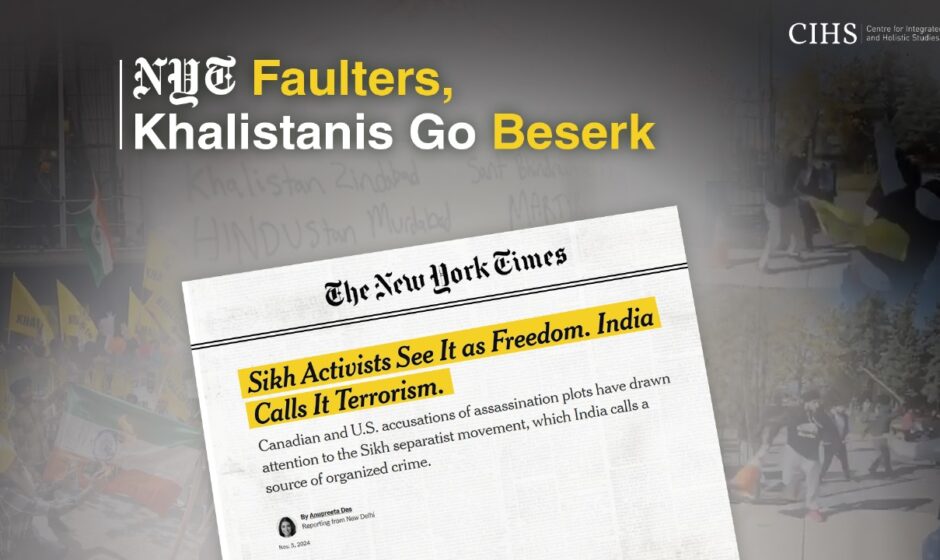Indian security concerns cannot be reflected from Khalistani terror lens.
Rohan Giri
Is it reasonable for reputed media platforms like The New York Times to arrive at conclusion even before piece the facts?

In her recent piece, “Sikh Activists See It as Freedom. India Calls It Terrorism,” Anupreeta Das paints the Indian response to Khalistani extremists’ movement as ‘overtly harsh and not based on genuine security concerns’.
The writer avers that Indian position against Khalistanis was overtly influenced by Hindu nationalist motives rather than security concerns. A closer look at the article reveals limited scope of investigation, relying on selected sources that shaped public perception in a skewed way.
By referring to select incidents, individuals, the write up risks simplifying a complex geopolitical issue, missing both historical and current context needed for a well-rounded understanding.
Emphasis on Canadian, US Perspectives
The article opens by focusing on Canadian and US claims of assassination plots against a terrorist thereby implying that India’s responses were excessive as “Khalistan movement” was regarded as a bygone issue.
The New York Times or Anupreeta Das presented evidence to conclude that Indian government had any role in assassinations. The write up also seem to have ignored the nuanced and ongoing nature of Khalistan issue within and beyond India’s borders. Khalistan-linked activities have not disappeared into thin air and Indian officials are cautious about connections between separatist groups, criminal elements and terror networks—connections that merit thorough analysis rather than dismissal as nationalism-driven rhetoric.
Findings from Indian and international intelligence agencies point to violent but fringe Khalistani elements receiving support, both material and ideological, from Pakistan, particularly through the Inter-Services Intelligence (ISI), known for its dirty tricks to destabilize India. This interlinked dynamic, often referred to as “bleed India with a thousand cuts” strategy is noted in several independent reports. Overlooking this context leaves out a significant geopolitical layer in the discussion.
What about Khalistan-Linked Violence?
One striking omission is the absence of data on violent history of Khalistan movement and its continued association with criminal activities. 1980s and 1990s saw that Punjab was virtually torn apart by extremist violence with thousands of civilians, law enforcement personnel and officials impacted by Khalistani terrorism. Ignoring these historical facts reduces the weight of ongoing vigilance against terrorist movements. By leaving out the history of violence and its effect on Punjab’s socio-economic landscape, the article doesn’t fully address why the Indian government views the Khalistan issue as a legitimate security concern.
Indian law enforcement including National Investigation Agency (NIA), reports that recent crimes tied to Khalistan include drug trafficking, gang violence and extortion contributing to Punjab’s drug crisis. A 2023 NIA report estimated that drug-related crimes in Punjab make up nearly 60 per cent of all drug cases nationwide, underscoring seriousness of the issue and suspected role of Khalistani networks. The absence of such statistics paint an incomplete picture of the government’s concerns.
Cherry Picking of Experts
The NYT article relies heavily on selective quotes from experts and analysts who cast India’s approach as extreme or unjust. For instance, statements from Gunisha Kaur on purported targeting of Sikhs under national security are included without broader context of the debate. By emphasizing voices critical of India’s measures against separatism, the article overlooks other scholars, counterterrorism experts, and analysts who have recognized valid security challenges India faces with Khalistan-linked extremism.
Certain Khalistani groups exploited Sikh religious sentiment to justify violent actions and criminal enterprises. Multiple forums have highlighted ties between these factions, drug and arms smuggling networks, often supported by ISI. Leaving out such perspectives raises questions about balance and intent to inform versus sway readers.
Impact of Biased Reporting on Public Understanding
When impactful media like The New York Times publish such pieces with biased slant, they risk cementing stereotypes and shaping public opinion misleadingly. For readers less familiar with Khalistan issue, India’s actions might appear authoritarian rather than responses to real and documented threats. Reporting with an apparent “predetermined” conclusion reinforces narratives that misrepresent India’s security concerns as mere authoritarian impulses.
This approach can erode trust in international relations. For instance, framing Canada’s reluctance to act against pro-Khalistan activists as a free speech issue disregards that many Western nations actively counter extremist ideologies promoting violence, from neo-Nazism to Islamist extremism. Yet when addressing Khalistani extremism, Canada’s stance is portrayed as liberal tolerance rather than a political decision. This selective framing risks distorting public understanding of global security policies, potentially engendering sympathy for extremist movements.
Conflating Sikh Identity with Khalistan
Das’ article could be read as equating India’s vigilance over Khalistani separatism with attack on Sikh identity, an oversimplification that overlooks the fact that most Sikhs globally do not support Khalistan.
For instance, San Jose California Gurudwara chief Bhupinder Singh Dhillon gave only five-minutes ultimatum to Khalistani supporters and drove them out of Nagar Kirtan. Similarly, Ujjal Dosanjh, former premier of British Columbia and federal cabinet minister under Liberal prime minister Paul Martin told Canadian newspaper ‘National Post’ that “a silent majority of Sikhs does not want to have anything to do with Khalistan, adding that less than five percent of the total Canadian Sikhs support Khalistani movement.”
India is home to one of the largest Sikh populations, with significant representation in the military, government, and business. Articles like Das’ risk alienating this community by implying Sikh identity aligns with separatism, which could strain relationships within the Sikh diaspora and between Sikhs and the Indian state of Punjab.
India’s Broader Counter-Terrorism Efforts
India’s response to separatism is not limited to Khalistan issue but spans various secessionist and insurgent movements from left-wing extremist naxalites to Islamist terrorism. In each instance, India’s approach has been complex, encompassing political dialogue, social programmes and security measures. For example, reducing violence in Kashmir through de-radicalization and security efforts shows a strategy aimed at balancing security with stability. Ignoring broader policies and isolating Khalistan issue risks misrepresenting India’s comprehensive security approach.
Importance of Balanced Journalism
Responsible media coverage should present readers with a complete view, allowing them to make informed judgments. Selective representation of incidents and perspectives risks misleading readers on complex issues like the Khalistan movement. Extremism and separatism are deeply consequential for societies and covering them demands the highest journalistic standards of balance and thoroughness. When reporting is driven by reinforcing biases rather than uncovering truths, readers ultimately miss out on the nuanced understanding essential to global discourse.
NYT’s article, as it stands, misses the mark for unbiased journalism. Rather than reinforcing one perspective, a more thorough analysis that recognizes India’s security concerns could bring the issue closer to readers’ complete understanding.
(Author is a doctoral Scholar at Amity University in Gwalior, content manager at Centre for Integrated and Holistic Studies, New Delhi)NYT Faulters, Khalistanis Go Beserk


